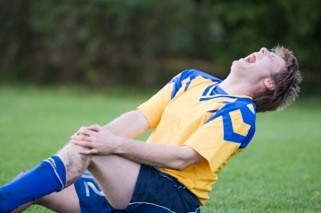399 Riversdale Rd
Hawthorn East 3123
Tel:(03) 9882 7753
Fax:(03) 9882 6114

Melbourne is the home of sport. We are blessed with so many sports being played at different levels. Unfortunately whether you are an elite/professional sportsman, or a casual weekend participator injuries can strike at any time.
Injuries suffered during sport cause many problems. Firstly we are often unable to continue playing and may miss that vital clash. Often there is pressure to return for finals or the start of the next season. Injuries can also have wider effects, keeping you off work and limiting your everyday activities.
The knee is made up of the femur (thigh bone) on the tibia (shin bone) with the patella (knee cap) sitting on the front of the femur. The ends of the bones are covered by a smooth joint cartilage. Between the femur and tibia, there are also two pads of cartilage wich act as shock absorbers between the bones. Each pad is called a meniscus. The knee is held stable by collateral ligaments on each side of the knee and cruciate ligaments in the centre of the knee. Muscles insert into the bones and when they contract, they move the bones.
When you injure yourself while playing sport, any or all of these structures can be injured. They can be stretched, torn or ruptured and the bones may fracture. Some of the more common serious injuries include anterior cruciate ligament (ACL) ruputure, meniscal tears and patella dislocaitons.
There are many simple things that you can do to decrease swelling and prevent further injury to the knee.
Apply ice to the knee immediately and a couple of times a day until the swelling settles. Make sure the ice is wrapped in a cloth rather than being in direct contact with the skin as this can cause cold burns. Leave the ice on for 20 minutes and then take it off for 20 mins before repeating.
Rest the injured leg as much as possible. Crutches will help take the pressure off that side when you walk.
Elevation of the injured leg is also very important. Have the leg propped up when you are sitting or lying. Ideally, your leg should be higher than the level of your heart. Put some bricks or phone books under the foot of your bed so that when you sleep, the leg is elevated.
A brace to keep the knee straight can be helpful in decreasing pain and minimising the chnace of further injury.
Many minor injuries, such as muscle strains settle on their own and do not require surgery. Ligament ruptures, cartilage tears and patella dislocations often do require surgery. The surgeons at Melbourne Hip and Knee will thoroughly assess you and your knee to determine whether you require surgery. You may require further scans to assist in making that decision. Our aim is to give you the best treatment that is most likely going to help you get back to playing sport. We have an Knee Injury Clinic that we run each week and we will be able to see you with a few days of your injury.